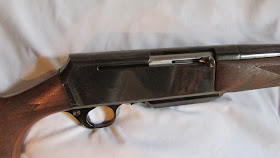Sorry to disappoint you, this restoration involves a Browning Automatic Rifle High-Power series. This is the sporting rifle created by the grandson of John Moses Browning: Bruce Warren Browning along with Marcel Olinger.
The sporting BAR was introduced by Browning Arms in 1967 and was produced in FN's Belgium plant.
This particular gun was a grade 1, it has none of the engraving that was common with higher grade Brownings.
According to Browning's website this particular gun was built in the 3rd year of production in 1969. You can check your serial number here.
I had two concerns in taking on this restoration:
1. The quality finish on FN's Browning guns is superb, I didn't feel comfortable that I could reproduce the results of the Herstal factory.
2. The dreaded "salted wood problem". If this gun is cursed with salted wood, there may be little if anything that I could do within the limited budget to clean up the gun.
If you know anything about Browning rifles & shotguns, you probably know about the "salted wood" problem.
In the mid 1960's Browning had trouble finding dried & stabilized walnut for their stocks. They had found a supply of fresh walnut from California, but they needed to dry them fast. Some "genius" decided to use a salt curing process.
Basically the stack of walnut planks were buried in salt. The salt leached out the moisture in the wood. That is all fine and dandy, the problem occurred when the water that leached out of the walnut on the top of the stack mixed with the salt and created a brine solution that then soaked into the wood in the middle and bottom of the stack.This wasn't noticed until years later when the salt began leaching from the wood causing the metal to rust on the rifles and shotguns. Supposedly this problem appeared on about 90% of the guns made during the 1966-1970 era (the 10% not affected must have been from the top of the stack?). By late 1969 the problem had been discovered and steps were made to prevent the rusting. Although some guns built as late as 1972 and even into the 1980s have the problem.
Here are the pictures of the gun when it arrived. Although it had rusty sling swivels and minor surface pitting, it showed no other signs of being a "salted rifle". I wont know for sure until I take it apart.
There is some strange green stuff stuck in the checkering of the fore stock.....gum? Silly Dough? booger?
Even with the freckling you can see my reflection in the side of the receiver. This is the worst of the rust.
Stay tuned for Part 2
References
Art's Gun Shop











Hi,
ReplyDeleteI have been looking at your work and it is truly remarkable. I recently inherited a Browning BAR, and I saw you refinished one as well. I see you did not Re blue yours, but mine will have to be. Any suggestions on getting the metal as close to original factory as possible? Also, any suggestions for pits that can’t be completely removed?
Thank you,
John
To do it right, you need to remove all the pits or replace the parts that are too heavily pitted. Then polish the barrel to a high shine (2500 grit at least).
ReplyDeleteBrownings were well known for having a very smooth, gloss finish.